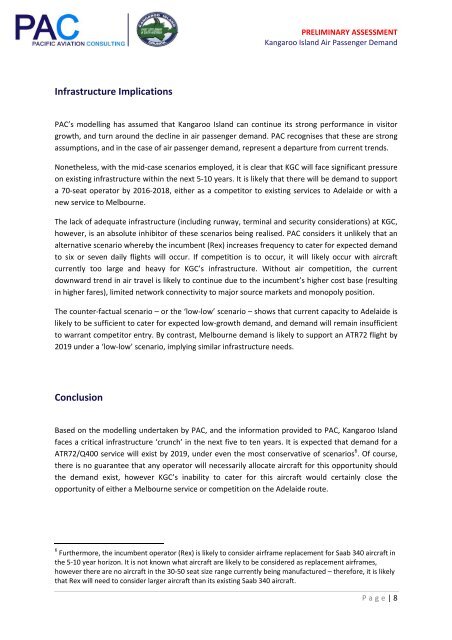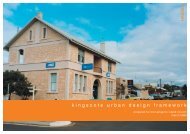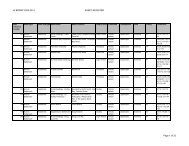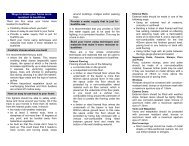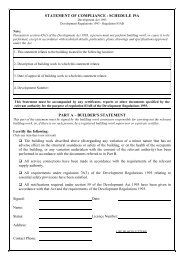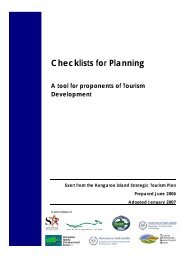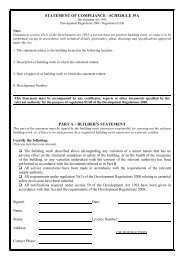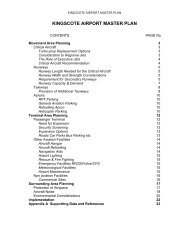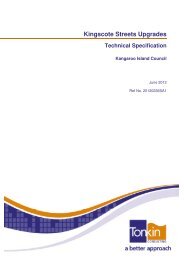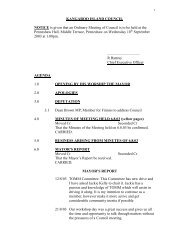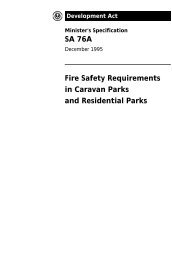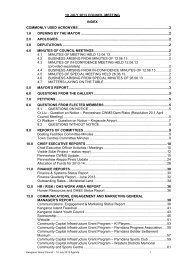Kingscote Airport Business Case Appendices - Kangaroo Island ...
Kingscote Airport Business Case Appendices - Kangaroo Island ...
Kingscote Airport Business Case Appendices - Kangaroo Island ...
- No tags were found...
Create successful ePaper yourself
Turn your PDF publications into a flip-book with our unique Google optimized e-Paper software.
PRELIMINARY ASSESSMENT<strong>Kangaroo</strong> <strong>Island</strong> Air Passenger DemandInfrastructure ImplicationsPAC’s modelling has assumed that <strong>Kangaroo</strong> <strong>Island</strong> can continue its strong performance in visitorgrowth, and turn around the decline in air passenger demand. PAC recognises that these are strongassumptions, and in the case of air passenger demand, represent a departure from current trends.Nonetheless, with the mid‐case scenarios employed, it is clear that KGC will face significant pressureon existing infrastructure within the next 5‐10 years. It is likely that there will be demand to supporta 70‐seat operator by 2016‐2018, either as a competitor to existing services to Adelaide or with anew service to Melbourne.The lack of adequate infrastructure (including runway, terminal and security considerations) at KGC,however, is an absolute inhibitor of these scenarios being realised. PAC considers it unlikely that analternative scenario whereby the incumbent (Rex) increases frequency to cater for expected demandto six or seven daily flights will occur. If competition is to occur, it will likely occur with aircraftcurrently too large and heavy for KGC’s infrastructure. Without air competition, the currentdownward trend in air travel is likely to continue due to the incumbent’s higher cost base (resultingin higher fares), limited network connectivity to major source markets and monopoly position.The counter‐factual scenario – or the ‘low‐low’ scenario – shows that current capacity to Adelaide islikely to be sufficient to cater for expected low‐growth demand, and demand will remain insufficientto warrant competitor entry. By contrast, Melbourne demand is likely to support an ATR72 flight by2019 under a ‘low‐low’ scenario, implying similar infrastructure needs.ConclusionBased on the modelling undertaken by PAC, and the information provided to PAC, <strong>Kangaroo</strong> <strong>Island</strong>faces a critical infrastructure ‘crunch’ in the next five to ten years. It is expected that demand for aATR72/Q400 service will exist by 2019, under even the most conservative of scenarios 6 . Of course,there is no guarantee that any operator will necessarily allocate aircraft for this opportunity shouldthe demand exist, however KGC’s inability to cater for this aircraft would certainly close theopportunity of either a Melbourne service or competition on the Adelaide route.6 Furthermore, the incumbent operator (Rex) is likely to consider airframe replacement for Saab 340 aircraft inthe 5‐10 year horizon. It is not known what aircraft are likely to be considered as replacement airframes,however there are no aircraft in the 30‐50 seat size range currently being manufactured – therefore, it is likelythat Rex will need to consider larger aircraft than its existing Saab 340 aircraft.Page| 8


